Hair loss is a common concern affecting millions of people worldwide. Enter Platelet-Rich Plasma (PRP) therapy – a cutting-edge solution that is changing the landscape of hair restoration. In this blog, we’ll explore how PRP works, its benefits, and why it’s becoming a go-to option for those seeking to reclaim their locks.
Understanding PRP: What is Platelet-Rich Plasma?
Platelet-Rich Plasma (PRP) is a concentration of platelets derived from the patient’s own blood. Rich in growth factors, PRP is used to stimulate cell growth and tissue regeneration, making it ideal for promoting hair growth.
PRP consists primarily of two compounds – red blood cells and a concentration of platelets within plasma. The platelets play a crucial role in the body’s healing process, as they release growth factors and proteins to promote cell repair and restoration. This ability to foster cellular regeneration means that PRP is especially effective for treating hair loss by rejuvenating hair follicles that have become dormant.
The Science Behind PRP and Hair Growth
PRP therapy involves drawing a small amount of blood, processing it to concentrate the platelets, and then injecting them into the scalp. The growth factors in PRP enhance hair follicular growth, promoting healthier and denser hair.
Research has shown that PRP injections stimulate new hair growth by prolonging the hair growth cycle. Studies, such as one published by PubMed Central, demonstrate significant increases in hair density following PRP treatment. This research provides compelling evidence supporting the efficacy of PRP in hair regrowth.
The mechanism by which PRP enhances hair growth is thought to involve several pathways. These include increased blood vessel formation around hair follicles, stimulation of dermal papilla cells, and prolonged anagen phase of the hair cycle. This multi-faceted approach ensures that PRP treatments offer a comprehensive solution to hair thinning by targeting the various factors responsible for healthy hair growth.
Advantages of PRP Over Traditional Methods
Unlike surgical hair restoration procedures, PRP is minimally invasive, uses the body’s own resources, and has minimal downtime. It’s a natural approach preferred by many patients seeking alternatives to drug-based treatments.
Traditional hair restoration methods, such as hair transplants and pharmaceuticals, can be effective but also come with their own sets of risks and limitations. For example, hair transplant surgery can be costly, invasive, and requires significant recovery time. Meanwhile, medications like minoxidil and finasteride may have side effects and need ongoing use to maintain results. In comparison, PRP harnesses your body’s own healing powers, making it a sustainable and organic solution.
Moreover, the absence of adverse side effects is another reason for PRP’s growing popularity. Because the treatment uses autologous blood, the risk of allergic reactions or infections is reduced considerably. The simplicity of the PRP procedure also makes it a favorable option for those looking for a straightforward yet effective treatment for hair loss.
Who Can Benefit from PRP Therapy?
PRP therapy is well-suited for individuals experiencing early hair thinning or certain types of alopecia. However, it is important to have a personalized consultation to determine its appropriateness for your specific needs.
For those struggling with conditions like androgenetic alopecia, PRP offers a suitable alternative especially for individuals who have not achieved satisfactory results from conventional treatments. While men have historically been the primary candidates for PRP, its use among women suffering from female pattern hair loss has surged, demonstrating PRP’s versatility and broad appeal.
Despite its many advantages, PRP might not be suitable for everyone. Individuals with certain medical conditions, such as thrombocytopenia or other blood-related disorders, may not be ideal candidates. It is always recommended to discuss your medical history and treatment goals with a qualified healthcare provider to ensure that PRP is a viable option for you.
What to Expect During and After PRP Treatment
PRP sessions are typically quick, lasting about an hour, with minimal discomfort. Post-treatment care is straightforward, and many people notice improvements in hair thickness and density within a few months.
During the procedure, a small blood sample is drawn from your arm. This blood is then placed in a centrifuge, carefully spun to separate the platelets from other blood components. This concentrated PRP is then injected into specific areas of your scalp using a fine needle. Despite involving multiple injections, most patients report minimal discomfort akin to a series of small pinches. The use of a topical numbing agent can alleviate any potential pain, putting any apprehensions to rest.
Aftercare involves simple guidelines such as avoiding harsh shampoos or hair treatments for a day or two. Depending on your hair loss severity and desired results, your skilled provider might recommend a series of maintenance sessions. Typically, patients undergo a series of treatments spaced several weeks apart to maximize benefits.
PRP: A Promising Future in Hair Restoration
PRP therapy is making waves in the fight against hair loss. By tapping into the body’s own healing abilities, it provides a less invasive and more natural alternative to conventional hair restoration options. As advancements continue and more people discover its benefits, PRP is on track to become a go-to treatment for anyone looking to restore their hair. For more information, check out https://adornmedspa.com/prp-for-hair/.

